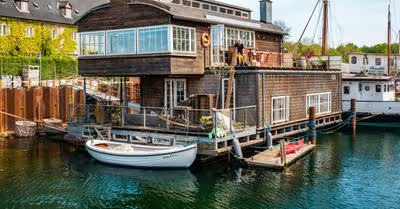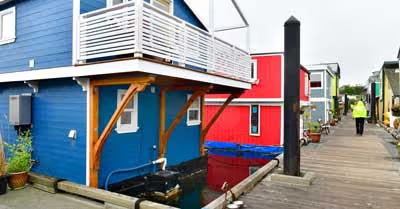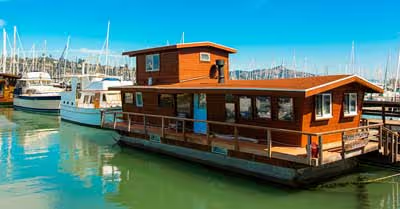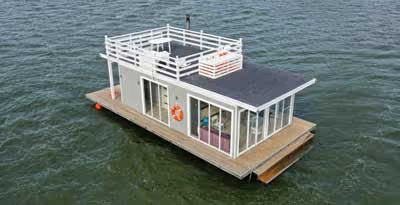
The Mississippi River is prime real estate for houseboat owners who love a long trip. But can you take a houseboat down the Mississippi?
Since houseboat laws tend to change and fines continue to rise, it's a good idea first to find out if you can take your houseboat up and down the Mississippi river before you set sail. After all, you don't want to set sail and then get in trouble with the authorities just because you were unaware.
The good news is - yes. Houseboat owners are allowed to move up and down the Mississippi river, provided they do not get in the way of passing vessels, wharves, or boat ramps on the river.
Since going down the Mississippi is a popular route for houseboat owners, here you will find out all there is to know, along with the best tips for traveling through the Mississippi in your houseboat.
As avid houseboat travelers, we can help guide you as you plan your journey through the Mississippi in a houseboat now that you know that it's a valid route to sail through.
Houseboat Laws
As a first-timer, taking your houseboat down the Mississippi can seem daunting. Luckily, you will find all the information you need right here. In the United States, all navigable waterways are owned by the government. Houseboat residents should be mindful of local and state laws, especially if traveling over state boundaries.
Because houseboats are transportable and on public land, their laws differ from those governing normal land dwellings. State gun regulations differ, and it's possible that bringing a firearm onboard without a permit is unlawful. Police officers may not require probable cause to board a watercraft in various states.
Also, submerged land is public land. The land up to the high watermark is also included. All submerged land inside a state's borders is held in trust for the people by the states. The states cannot sell the rights to submerged land.
Everyone has the right to utilize the water for commerce, fishing, bathing, swimming, boating, and other leisure activities. States cannot dedicate submerged property for private use, but they do have the authority to regulate water use.
This is why it is always best for you to find out the rules and regulations first before taking your houseboat out to these areas.
Each state enacts anchoring legislation that is tailored to the demands of a certain region. For example, some municipalities mandate that all vessels anchored for more than two weeks obtain a harbor permit.
Any vessel staying within the authority of their harbormaster for more than 48 hours has the harbor master's authorization. According to Mississippi law, vessels may not anchor in any location that might hinder a passing vessel, boat ramp, dock, or other structure.
For instance, the state of Florida created precise standards that identify houseboat occupants in reaction to confrontations between boaters, landowners, and law enforcement. Liveaboards are not regulated by local governments. Any vessel that is utilized as a habitation rather than for navigation is referred to as a liveaboard vessel.
Taking a Houseboat on the Mississippi
The Mississippi River is entirely navigable by boat. The river's navigable segment begins at Minneapolis' Coon Rapids Dam on the upper Mississippi River. You may take a motorboat down the river for the remaining 1,800 miles from that dam until you reach the Gulf of Mexico.
Depending on your planning, traveling the Mississippi by boat might be a fantastic adventure or a disastrous disaster. Many spots would be great for those who just want to grab their houseboat, but as you approach closer to the river's mouth, chances to stop and fill up the fuel tank become less.
In many sections, simply grabbing your boat and hitting the water would suffice, but as you approach closer to the river's mouth, places to stop and fill up become increasingly few. On the lower Mississippi, there is a region where it is nearly 400 miles between stations to refuel.
If you don't plan ahead to ensure you account for everything, your ideal trip might turn unbearable as you float helplessly down the Mississippi, trying to locate a location to refuel.
The Mississippi River system is the biggest river system in North America, flowing for more than 2,000 miles and passing directly through ten states. The Mississippi River can take tourists through a graphic history of United States geography as well as bring out the difference of climates from Minnesota to Louisiana.
There are several organizations that specialize in Mississippi River cruises, whether passengers are looking for a short day trip or an extensive excursion that covers the river's length.
Safety Issues When on the Mississippi
Houseboats, Barges, and other big ships often go up the Mississippi, so if the houseboat is large enough, it is probably feasible to travel up the river. The Mississippi is far more difficult to navigate upstream than it is to navigate downstream.
It is possible to boat up the Mississippi, but it is tough and would need a huge boat with powerful engines. Apart from the strong river current while moving up the Mississippi, you'd also have to contend with trash pouring downstream and other boats traveling at a much quicker rate than you.
While going down the Mississippi is not too difficult, coming up is a whole different ball game. The fundamental question is whether you can or should boat up the Mississippi. We advise avoiding coming up the Mississippi if you want to use a recreational boat.
It will not only take considerably longer since you will be battling the current, but it will also be a very unpleasant voyage. This is because you will have to contend with traffic – barges and other boats moving upstream a lot quicker.
Rather than fighting the mighty Mississippi upstream, you can take the Great Loop, which is considered to be a much better way to get to the upper Mississippi.
Best Time to Go Down the Mississippi
Houseboats for rent in Wisconsin's communities of LaCrosse and Alma and in Lansing, Iowa, may accommodate two to fourteen people. The firms offer you a spot guide who will accompany you for the first hour or two of your excursion to help you learn how to steer the boat, anchor, and navigate.
Your guide just climbs on a small boat tethered to the rear of the houseboat and departs once you're satisfied with the abilities you'll need. Between mid-May and mid-October, a few firms on the Mississippi River rent houseboats, but you can explore the Mississippi on your own houseboat.
Alma, Wisconsin, is the starting point for your own houseboat excursion on the Mississippi River. Take to the water aboard one of five maneuverable houseboats, preferably one with a full kitchen and a variety of other convenient features.
If you prefer a "boatel" experience, you may rent a houseboat at the marina and call it home for the duration of your visit. Houseboats are allowed upstream as far as Lake City and downstream as far as Fountain City. It would be tough to incorporate everything into one trip because this tiny stretch of the Mississippi is so rich in history and distinctive sights.
Explore the Mississippi River from a houseboat's unique perspective. Pull onto a side lake during the day to slide down the boat's slide into the cold water and go for a swim, or anchor and let the waters rock you to sleep. While the Mississippi is accessible along its entire length, the Upper Mississippi is where you'll find the bulk of houseboats for hire north of Cairo, Illinois.
The Mississippi River loses its nature below Cairo. To get to a muddy beach, you'll have to wade through sucking muck instead of sandy beaches. Some places have distances between services of up to 500 miles, demanding cautious preparation to prevent becoming stuck.
The Lower Mississippi's rapid currents make it difficult for inexperienced captains, and houseboat rentals are scarce. Exiting the Mississippi at Cairo and using the Tennessee Tombigbee Waterway is a better option if you're serious about getting to the Gulf of Mexico.
The Upper Mississippi features beautiful beaches, beautiful landscapes, and tiny villages with amenities and interesting sites. You may even visit isolated party sites, such as sandbars or beaches accessible only by boat, to play water volleyball, splash in the water, or simply chat. You'll also have to keep an eye out for threats.
The Wing and Weir dams are structures that stretch into the river to redirect water back to the main channel. A ripple in the water is generally all it takes to spot them, and if you run up on one, your boat may become trapped. To bypass the Chain of Rocks, all boats must abandon the river and utilize a side canal around Mile 195, north of St. Louis.
The Mississippi River is famous for its catfish, and the lower Mississippi River is especially popular for sport fishing. Flathead catfish, as well as blue and channel catfish, are best fished during the warmer months, often from late spring through late summer.
February through October is the finest season to go catfish fishing in Missouri. Keep in mind that channel catfish favor regions with sluggish currents, such as dikes, side channels, and oxbows, while looking for catfish fishing spots. The main canal is more likely to have blue catfish.
How Long Does it Take?
Of course, the time it takes to go from one destination to the next is always going to be a major factor while planning your trip down the Mississippi River. The length of time it takes to go down the Mississippi is determined by where you begin, how fast you move, and how many hours you travel every day.
Yes, you may travel the whole length of the Mississippi River, but the upper 482 miles will necessitate the use of a kayak or rowboat. After those first 482 miles, you may cruise the rest of the way down the river in almost any motorboat. Because the route becomes less pleasurable as you get closer to the Gulf, many people choose for the Tennessee-Tombigbee.
There are few places to stop for fuel on the lower part, and there will be a lot of barge and tugboat activity to contend with. If your boat travels at 15 mph, you can cover 180 miles in a day if you go for 12 hours.
Starting at the Coon Rapids Dam in Minneapolis, you could reach the Gulf in just over ten days. Obviously, going 12 hours a day for ten days straight would not be very pleasurable, so if you want to do it at a more leisurely pace, it might easily take a month or more to cruise down the Mississippi by boat.
Taking your houseboat through the Mississippi is certainly going to be a treat. You may enjoy the experience by living aboard a moored vessel if avoiding the risks of the river sounds too overwhelming.










